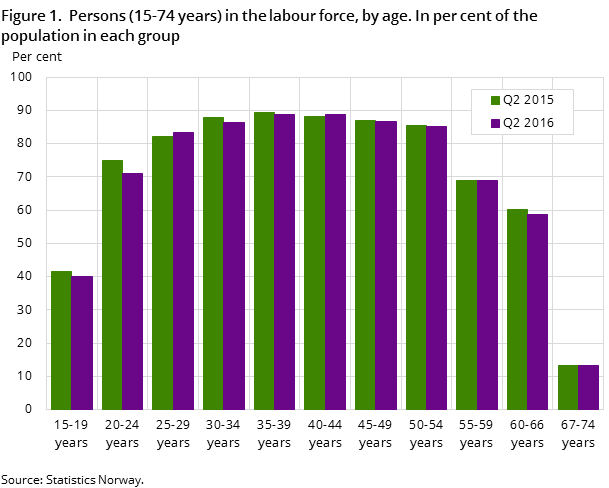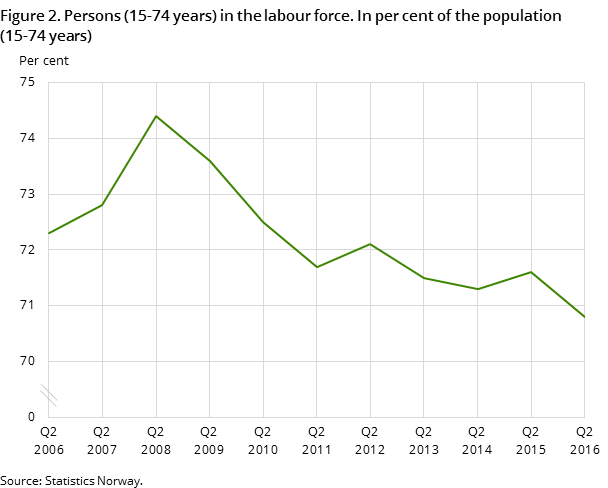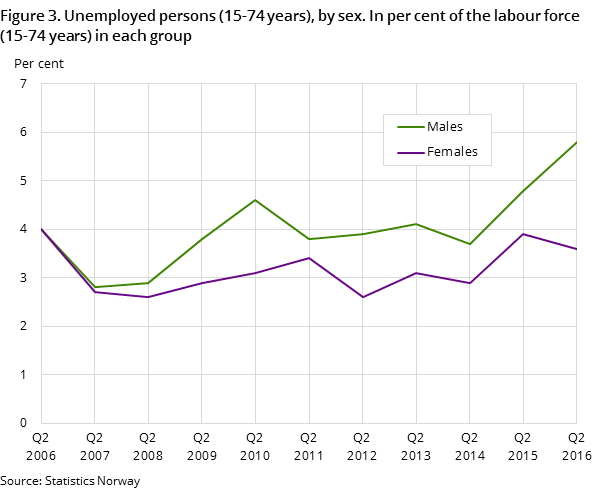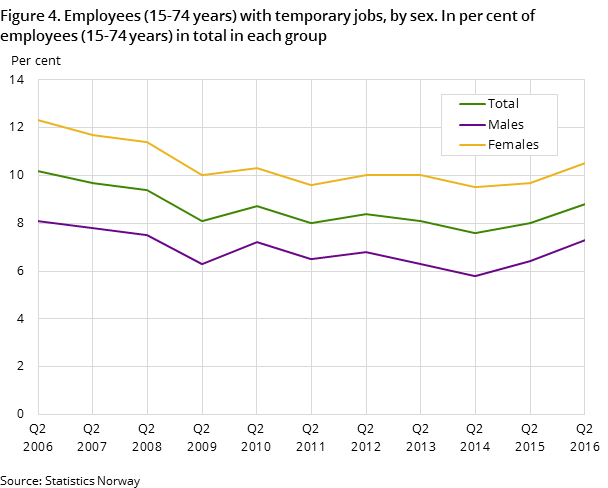Content
Published:
This is an archived release.
Fewer young people employed
From the second quarter of 2015 to the second quarter of 2016 there was a reduction of 22 000 people in employment in the age group 15-24. Most of the reduction was in full-time employment. An increasing number of people in this age group claimed to be in education.
| 2nd quarter 2016 | 2nd quarter 2015 - 2nd quarter 2016 | |||
|---|---|---|---|---|
| Absolute numbers | Per cent | Change in absolute numbers | Change in percentage points | |
| Labour force | ||||
| Both sexes | 2 781 000 | 70.8 | -4 000 | -0.8 |
| Males | 1 483 000 | 73.9 | 6 000 | -0.5 |
| Females | 1 298 000 | 67.5 | -9 000 | -1.2 |
| Employed persons | ||||
| Both sexes | 2 647 000 | 67.4 | -16 000 | -1.0 |
| Males | 1 396 000 | 69.6 | -10 000 | -1.2 |
| Females | 1 251 000 | 65.0 | -5 000 | -1.0 |
| Unemployed | ||||
| Both sexes | 134 000 | 4.8 | 12 000 | 0.4 |
| Males | 87 000 | 5.8 | 16 000 | 1.0 |
| Females | 47 000 | 3.6 | -4 000 | -0.3 |




Since the working-age population and the number of unemployed in the age group 15-24 were both unchanged, there was a reduction in the labour force participation rate (the labour force as a percentage of the working-age population) of 2.9 percentage points from the second quarter of 2015 to the second quarter of 2016.
The Labour Force Survey (LFS) shows that the labour force participation rate among the population aged 15-74 years was 70.8 per cent in the second quarter of 2016, down 0.8 percentage points from the same quarter the previous year. The decrease was mainly among the under 25s – especially among women.
Employment decreased
The number of employed persons went down by 16 000 from the second quarter of 2015 to the second quarter of 2016. Employment among the under 25s decreased by as much as 22 000 persons, mainly among those in a full-time job. In the same age group in the same period of time, an increasing number of people stated that school or studying was their main activity.
The LFS shows a continued drop in mining and quarrying – an industry dominated by oil and gas extraction. The number of employed persons (15-74 years) decreased by 11 000 or 16 per cent from the second quarter of 2015 to the second quarter of 2016. In the same period, the number of employed persons in wholesale and retail trade dropped by 9 000. Health and social work and personal services were the industries with the greatest increase in the number of employed persons, with 18 000 and 5 000 persons respectively compared to the same quarter of 2015.
Increase in long-term unemployment
In the second quarter of 2016, there were 134 000 unemployed persons, up 12 000 from the same quarter in the previous year. Among men, the increase was 16 000, while for women there was a decrease of 4 000. The increase was among the long-term unemployed, i.e. persons who have been unemployed for more than 26 weeks. The share of long-term unemployed among the total unemployed was 38 per cent in the second quarter of 2016, up from 29 per cent in the second quarter of 2015. In the second quarter of 2016, the average period of time an unemployed person had been unemployed was 32 weeks; as much as eight weeks longer than the same quarter in the previous year.
More employees with temporary jobs
The number of employees on temporary contracts went up by 19 000 from the second quarter of 2015 to the second quarter of 2016. In health and social work the number of employees with temporary jobs increased by 9 000. In total, for all industries, temporary employment increased from 8.0 to 8.8 per cent. The percentage of temporary employment was highest in personal services and in accommodation and food service activities, with 17 and 14 per cent respectively. In education and health, and in social services, the percentage was almost as high, at 14 and 13 per cent respectively. The lowest proportion of temporary employment was in financial and insurance activity, with 3 per cent of all employees, according to the LFS.
Small changes in underemployment
The 69 000 who were underemployed in the second quarter of 2016 represented 10 per cent of all part-time employed, unchanged from the second quarter last year. The majority of those underemployed are women (46 000), which must be seen in conjunction with the high proportion of women working part time.
Contact
-
Arbeidsmarked og lønn
E-mail: arbeidsmarked@ssb.no
-
Erik Herstad Horgen
E-mail: erik.horgen@ssb.no
tel.: (+47) 93 08 68 62
-
Ole Sandvik
E-mail: ole.sandvik@ssb.no
tel.: (+47) 99 04 82 06
-
Håvard Hungnes Lien
E-mail: havard.lien@ssb.no
tel.: (+47) 40 90 26 06
